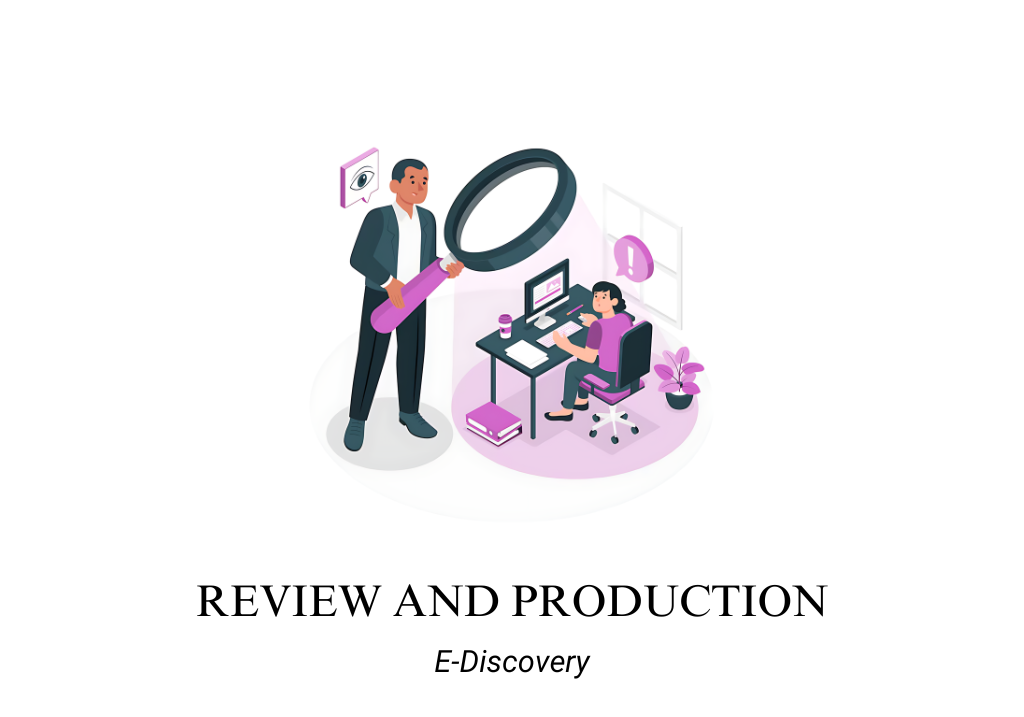Introduction
Review and production are critical functionalities within e-discovery tools, focusing on the examination, categorization, and eventual production of electronically stored information (ESI) for legal proceedings. This functionality involves meticulously reviewing collected data, applying coding and annotations, managing the review process through workflows, and ensuring that all actions are documented for transparency and compliance. Review and production are essential steps in the e-discovery process, following the search and processing of data, and are crucial for preparing and presenting evidence in court.
Purpose
The purpose of review and production functionality is to ensure that all relevant information is accurately reviewed, appropriately coded, and produced in a legally compliant manner. This functionality is designed to streamline the review process, enhance the accuracy of legal analysis, and ensure that the data produced meets legal standards. By effectively managing the review and production process, legal teams can reduce risks, avoid sanctions, and present well-organized evidence that supports their case.
Benefits
- Accurate Data Review: Ensures that all relevant data is thoroughly examined and correctly categorized, reducing the risk of overlooking critical information.
- Streamlined Workflow: Improves efficiency by automating and organizing the review process, allowing legal teams to focus on the most important aspects of the case.
- Compliance Assurance: Helps maintain compliance with legal and regulatory requirements by documenting all actions taken during the review and production process.
- Risk Mitigation: Reduces the risk of producing privileged or irrelevant information by applying rigorous review controls and audit trails.
- Transparent Documentation: Provides a clear audit trail that records every action taken during the review process, ensuring accountability and defensibility.
CHECK MORE: Guide to find best E-Discovery tools for lawyers
Features
Review and Analysis
Meaning:
Review and analysis is a feature that allows legal professionals to examine and interpret the collected ESI to determine its relevance, privilege status, and importance to the case. This process involves the detailed assessment of documents, emails, and other data to identify key evidence.
Purpose:
The purpose of review and analysis is to ensure that all data relevant to the legal matter is accurately identified and assessed. This feature helps legal teams to separate pertinent information from irrelevant or privileged content, which is crucial for building a strong case and ensuring that only relevant evidence is produced.
Use Cases:
- Relevance Review in Litigation: A legal team conducts a review to identify documents that are directly related to the case at hand, separating them from irrelevant or non-responsive materials.
- Privilege Analysis: During a review, attorneys analyze communications to determine whether they are protected by attorney-client privilege, ensuring that privileged information is not inadvertently disclosed.
Coding and Annotations
Meaning:
Coding and annotations refer to the process of categorizing documents and adding notes or tags that indicate their relevance, privilege status, or other important attributes. This feature allows reviewers to systematically organize and mark up documents for easier retrieval and analysis.
Purpose:
The purpose of coding and annotations is to facilitate the organization and retrieval of documents during the review process. By applying consistent coding and detailed annotations, legal teams can quickly identify and categorize documents based on their importance and relevance, improving the efficiency and accuracy of the review.
Use Cases:
- Document Categorization: A legal team codes documents as relevant, non-relevant, or privileged, making it easier to manage large datasets and ensuring that only appropriate documents are produced.
- Detailed Annotations: During the review process, attorneys add annotations to key documents, highlighting important passages or noting areas that require further investigation or analysis.
Process Control
Meaning:
Process control is a feature that manages and monitors the review workflow, ensuring that each step in the process is completed correctly and in the proper sequence. It includes setting up review protocols, managing reviewer assignments, and tracking the progress of the review.
Purpose:
The purpose of process control is to ensure that the review process is conducted systematically and in accordance with established protocols. This feature helps to maintain consistency, efficiency, and accuracy throughout the review, reducing the risk of errors or omissions.
Use Cases:
- Review Management: A law firm sets up process controls to assign specific batches of documents to different reviewers, ensuring that each team member follows the same review protocols.
- Progress Tracking: A corporate legal department uses process control to monitor the progress of document review, ensuring that deadlines are met and that all documents are reviewed consistently.
Review Workflow
Meaning:
Review workflow is a feature that automates and organizes the sequence of tasks involved in the document review process. It includes assigning tasks to reviewers, setting priorities, and managing the flow of documents through different stages of review.
Purpose:
The purpose of the review workflow is to streamline the review process by providing a structured and automated approach to managing the flow of documents. This feature ensures that the review process is efficient, well-organized, and capable of handling large volumes of data.
Use Cases:
- Workflow Automation: A legal team sets up a review workflow to automatically assign high-priority documents to senior attorneys, ensuring that the most critical evidence is reviewed first.
- Task Management: A review workflow is used to manage and track the distribution of documents among multiple reviewers, ensuring that the workload is balanced and that all documents are reviewed in a timely manner.
Audit Trail
Meaning:
An audit trail is a feature that records every action taken during the review and production process, including who accessed documents, what changes were made, and when these actions occurred. This feature provides a detailed history of the review process, ensuring transparency and accountability.
Purpose:
The purpose of the audit trail is to document the entire review process, providing a clear record that can be used to demonstrate compliance with legal standards. This feature is essential for maintaining the integrity of the review process and ensuring that all actions are defensible in court.
Use Cases:
- Compliance Documentation: A law firm uses the audit trail to document the entire review process, ensuring that they can demonstrate to the court that all documents were handled according to legal standards.
- Risk Management: An organization relies on the audit trail to monitor and review the actions taken during document review, ensuring that no unauthorized changes were made and that all actions are fully documented.
Conclusion
These features within the review and production functionality are vital for ensuring that e-discovery processes are thorough, accurate, and legally defensible. By leveraging these features, legal teams can efficiently review and produce relevant electronic evidence while maintaining high standards of compliance, transparency, and accountability.
CHECK OUT E-DISCOVERY TOOLS ON DIRECTORY OR CLICK HERE


